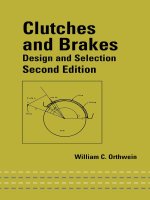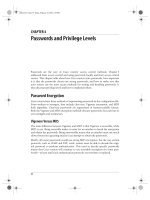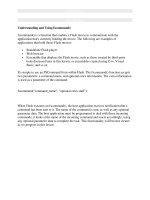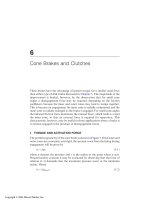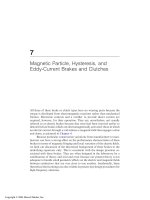Tài liệu Clutches and brakes design and selection P7 pdf
Bạn đang xem bản rút gọn của tài liệu. Xem và tải ngay bản đầy đủ của tài liệu tại đây (911.06 KB, 25 trang )
7
MagneticParticle,Hysteresis,and
Eddy-CurrentBrakesandClutches
Allthreeofthesebrakeorclutchtypeshavenowearingpartsbecausethe
torqueisdevelopedfromelectromagneticreactionsratherthan mechanical
friction.Electroniccontrolsandarectifierto providedirectcurrent are
required,however,fortheiroperation.They are,nevertheless,notusually
referredtoaselectricbrakesbecausethattermhadbeenreserved earlierto
denotefrictionbrakeswhichare electromagneticallyactivated:thoseinwhich
anelectriccurrentthroughacoilinducesamagneticfieldthatengagesashoe
anddrum,aspicturedinChapter4.
Because particular construction variations from manufacturer to man-
facturer can have a strong effect on the performance characteristics of these
brakes in terms of magnetic fringing and local variation of the electric fields,
we limit our discussion of the theoretical background of these brakes to the
underlying equations only. This is consistent with the design practices as-
sociated with these brakes. They are often designed in the laboratory by a
combination of theory and trial and error because our present theory is not
adequate to handle small geometric effects on the electric and magnetic fields
between conductors that are very close to one another. Incidentally, these
theoretical shortcomings are also evident in present-day design procedures for
high-frequency antennas.
Copyright © 2004 Marcel Dekker, Inc.
Since these formulas are not presented with sufficient detail for the
reader to design magnetic particle, hysteresis, or eddy-current brakes, they
will not be summarized at the end of the chapter.
I. THEORETICAL BACKGROUND
The basic equations that define the theory used in explaining the generation of
eddy currents and of hysteresis loops are presented in the remainder of this
section. A more complete discussion of the theory, beginning with Maxwell’s
equations, equations (1-1), along with the derivation of the subsequent
relations may be found in Stratton [1] and in Lammeraner and Starl [2].
Units for the quantities involved will be given according to the MKS system
(acronym for meters, kilograms, seconds).
Maxwell’s equations (1-1) in vector form are generally taken as the
starting point for the study of the interdependent electric and magnetic fields
in free space sufficiently far from their generating electron flows. These two
vector equations are
j  E þ
BB
Bt
¼ 0
j  H BD
Bt
¼ J
ð1-1Þ
in which i, j, and k denote unit vectors in the positive x-, y-, and z-directions,
respectively.
Here, E denotes the electric field intensity (volts/meter), H the magnetic
field intensity (ampere-turns/meter), B the magnetic induction (webers). J the
current density (amperes/meter
2
, and t the time (seconds); the operator j is
defined by
ju
iB
Bx
þ
jB
By
þ
kB
Bz
It can be shown [1] as well that the following relations hold in free space:
j Á B ¼ 0 and j Á D ¼ U
D ¼ q
o
E and H ¼
B
A
o
ð1-2Þ
where U denotes the charge density (coulombs/meter
3
) and constants q
o
and A
o
denote the electric and magnetic permeabilities of free space, respectively. In
the MKS system, the units of q
o
are farads/meter and the units of A
o
are
henries/meter.
Chapter 7126
Copyright © 2004 Marcel Dekker, Inc.
Within an isotropic and homogeneous material, equations (1-1) are
replaced by the following set of equations:
j  E þ
BB
Bt
¼ 0 j  B À e
o
A
o
BE
Bt
¼ A
o
J þ
BP
Bt
þ j  M
ð1-3Þ
j Á B ¼ 0 j Á E ¼
1
e
o
U À j Á PðÞ
where polarization vector P and magnetization vector M are defined by
P ¼ D À e
o
E and B ¼ A
o
H þ M þ M
o
ðÞ ð1-4Þ
because both P and M vanish in free space. The last two of equations (1-2) are
replaced by
D ¼ eE and H ¼
1B
A
ð1-5Þ
in which q and A are called the inductive capacities of the medium.
After adding Ohm’s law, which is that
I ¼
E
V
ð1-6Þ
in a medium having resistance V(ohms), we have all of the relations that
together explain the generation of an eddy current I and a hysteresis loop for
H in a homogeneous, isotropic medium [2].
The electric current flowing across a surface in the material is given by
I ¼
Z
S
J Á n ds ð1-7Þ
In our discussion of electric brakes that induce a magnetic field, which is
the primary source of the braking torque, we shall be concerned only with
equation (1-4) and the equation for the work done by cyclic changes in the
magnetic induction within a material volume V, which is
W ¼À
Z
V
dv
l
B Á dH ð1-8Þ
Magnetic induction B in the material is induced by an external H field,
which in turn is usually generated by a current I in a coil of wire according to
H ¼ NI ð1-9Þ
where N is the number of turns of wire in the coil.
Magnetic Particle, Hysteresis and Eddy-Current Brakes 127
Copyright © 2004 Marcel Dekker, Inc.
Calculation of work W according to equation (1-8) involves substituting
for B from equations (1-4) to get
W ¼À
Z
V
dv
1
A
l
B Á dB
ð1-10Þ
which is nonlinear because of the interdependence of M, A,andB. Depending
on the material, the relation between B and H may appear as in Figure 1(a) or
(b). It is the nature of these curves that determines the torque-control current
F
IGURE
1 Representative hysteresis loops for (a) low-loss material and (b) high-
loss material.
Chapter 7128
Copyright © 2004 Marcel Dekker, Inc.
curve, represented by Figure 2, for a hysteresis brake. Techniques for gen-
erating the cyclic behavior of B and using it for braking are discussed in the
sections devoted to individual brake designs.
Eddy currents are generated within a conducing material whenever the
magnetic field changes, as implied by the relation for J in equations (1-3). For
design purposes, the power P
e
lost due to cyclic eddy-current variations in a
flat plate may be estimated from
P
e
¼
kyfB
max
ðCkÞ
ð1-11Þ
where y represents the plate thickness, f is the frequency of the cyclic variation,
k is the specific resistance of the material, and C is a dimensional constant.
Although these relations indicate that hysteresis and eddy currents oc-
cur together in eddy-current and hysteresis brakes, one or the other may be
made to dominate by selecting a material with the proper combination of A
and k.
F
IGURE
2 Typical torque control current curves for a hysteresis brake. Arrows in-
dicate increasing or decreasing coil current. (Courtesy of Magnetrol, Inc., Buffalo,
NY.)
Magnetic Particle, Hysteresis and Eddy-Current Brakes 129
Copyright © 2004 Marcel Dekker, Inc.
II.MAGNETICPARTICLEBRAKESANDCLUTCHES
Thesebrakesareavailableinarangeofsizesthatincludethe100-lb-ftmodel
showninFigure3andthe8-lb-ftmodelshowninFigure4.Sincethesecon-
figurationsareequallysuitedforclutches,theymaybecombinedtoform
clutch-brakecombinations,asinFigure5.Whenusedasaclutch,theunithas
twomovingparts;whenusedasabrakeithasonlyone.
Whenusedasaclutch,theconfigurationisasrepresentedbythesche-
maticinFigure6(a).Theinputshaftisattachedtoacylindricaldrum,termed
the outer member, or OM, which encases a smaller, inner cylinder, termed the
inner member, or IM, which is attached to the output shaft. A dry, finely di-
vided, proprietary magnetic material is contained in the region between the
F
IGURE
3 Magnetic particle brake with a 100-lb-ft capacity. (Courtesy of Sperry
Electro Components, Durham, NC.)
Chapter 7130
Copyright © 2004 Marcel Dekker, Inc.
OMandtheIM.Thebrakeconfigurationdiffersfromtheclutchonlyinthat
theIMisrigidlyattachedtothebrakeframe.
AnelectromagneticcoiloutsidetheOMandconcentricwithitisusedto
activatethebrakeorclutch.Whenthecoilinenergizedbypassingcurrent
throughitamagneticfieldisestablishedwhichcausestheparticlestobridge
thegapbetweentheIMandtheOMandformlinksbetweenthetwo,as
representedinFigure6(b).Theselinksarealongthemagneticlinesofforce,
whicharemadenearlyperpendiculartotheOMbytheconfigurationofthe
OMandthecoilhousing,asshowninFigures6and7.
Boththeshearandtensilestressesintheselinksresistrelativemotion
betweentheIMandtheOMandsotransmittorqueforthebrake/clutch.
Theseshearandtensilestressesdevelopedaredependentonthecoilcurrent
F
IGURE
4Hysteresisbrakewitha8-lb-ftcapacity.(CourtesyofMagneticPower
Systems, Inc., Fenton, MO.)
Magnetic Particle, Hysteresis and Eddy-Current Brakes 131
Copyright © 2004 Marcel Dekker, Inc.
andareindependentofrotationalspeed.Typically,thetorquevarieswiththe
coilcurrent,asillustratedinFigure8,whilethetorqueremainsconstant
regardlessoftherotationalspeedoftheOM,asshowninFigure9.
III.HYSTERESISBRAKESANDCLUTCHES
Constructionofahysteresisclutch,showninFigure10,differsfromthatofa
hysteresisbrakeonlyinthattheoutermember,termedtheOM,isprevented
fromrotating.Thisschematicimpliesthatinthebrakeconfigurationthecoil
windingoccupiesagreaterportionofthebaseofthecup-shapedOM,as
indicatedintheschematicinFigure11.
Ineitherconstructionthecup-shapedOMisfittedwithacentralpost
thatfitswithinthesmallercup-shapedinnermember,termedtheIM.
MagneticfieldvariationisaccomplishedbyreticulatingtheOMwellsand
post,asindicatedinFigure12(a)toproduceanalternatingsetofnorthand
southmagneticpoleswhentheOMismagnetizedbycurrentflowingthrough
thecoilinitsbase.Atanyinstantthemagneticfieldfromthesepolesinducesa
setofoppositepolesinthewallsoftheIM.RotationoftheIMis,therefore,
F
IGURE
5Magneticparticleclutchandbrakecombination.(CourtesySimplatrol
Dana Industrial, Webster, MA.)
Chapter 7132
Copyright © 2004 Marcel Dekker, Inc.
opposedbythemagneticforcebetweentheinducedpolesintheIMandthose
intheOMbecauseitdisturbsthisarrangementbyforcingoppositepoles
apartandsimilarpolestogether.Astherotationcontinuesduetoexternal
shafttorque,themagneticfieldfromtheOMchangesthemagnetizationof
eachpointinthemagnetizedregionoftheIMsothatthemagneticinduction
BatanypointonthewallsoftheIMtraversesthehysteresisloopasthatpoint
movesunderthenorthtosouthtonorthpoleoftheOM’soutershell.
ByformingtheIMfromamagneticallyhardmaterial(onethatresistsa
changeinmagnetizationasindicatedbyasmallvalueofA)whichalsohasa
largeareaenclosedbythehysteresisloop,themanufacturercanassure
relativelylargelossesinthebrake.Theenergyextractedfromtheinputshaft
inthismannerheatstheIM,whichmustbecooledtomaintaintheperform-
anceofthebrake.
Figure13clearlyshowsthatthebrakingtorqueismaximumforlow
rotationalspeed,including0rpm,andthatasthespeedincreasesacritical
pointisreachedwhichcorrespondstothemaximumpowerthatcanbe
dissipatedbythebrake,basedonitsinternalconstructionandtheambient
temperature.
F
IGURE
6Schematicofamagneticbrake/clutchtodisplayitsoperation.(a)
Magnetic particle clutch. (b) Input shaft ‘‘R’’ and output shaft ‘‘N’’ are positioned
within the electromagnetic coil. Magnetic particles lay loosely between input and
output components. No current is applied to the coil. No torque is transmitted. (c)
Here maximum current energizes the coil. The clutch now operates at 100% of
clutch rating. Full transmission of torque occurs. Depending on coil current, any
level between 0 and 100% torque transmission is possible. (Courtesy Magnetic
Power Systems, Inc., Fenton, MO.)
Magnetic Particle, Hysteresis and Eddy-Current Brakes 133
Copyright © 2004 Marcel Dekker, Inc.
F
IGURE
6 Continued.
Chapter 7134
Copyright © 2004 Marcel Dekker, Inc.
